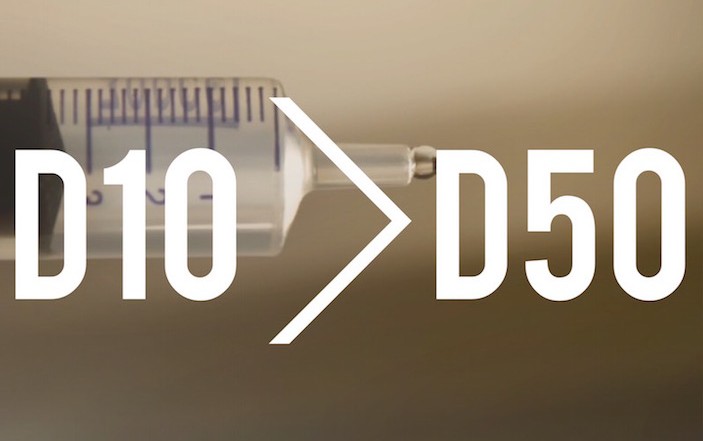Emergency physicians should consider switching from D50W to the safer, less error-prone, equally effective D10W when treating hypoglycemia.
“An amp of D50” – 25 grams of glucose in a 50 mlprefilled syringe (50% glucose) – is, and has been since at least the middle of the last century, a standard parenteral treatment by U.S. emergency physicians for significant hypoglycemia. An amp of D50 provides five times the amount of glucose in a normal adult’s blood. The PALS-recommended pediatric dose of 0.5-1g/kg of glucose (diluted to D25, D12.5 or D10) provides 6-11 times the amount of glucose in the blood of a normal child. The recommended pediatric dose administered over a minute or two provides 50-100 times the amount of glucose that the body can use during that time.
Glucose is the brain’s primary fuel and is essential for normal cerebral functioning, but GLUT3, the primary glucose transport protein in the CNS with a high affinity for glucose, is saturated at normal blood glucose levels. Why do we use such large and concentrated doses of glucose to treat hypoglycemia? Likely because of tradition, because these doses work and because blood glucose measurements used to take hours to days to get results. Now that we have nearly instant reading glucometers, why not titrate smaller amounts of glucose, such as 0.1g/kg, based on CBG and GCS levels to reduce post-treatment hyperglycemia, a particular contraindication in patients with strokes? D10, glucose 10g in 100 ml (10% glucose), is markedly less hypertonic than D50 (D10 505 mOsm/L; D50 2,525 mOsm/L; blood plasma 285-295 mOsm/L) so much less likely to cause skin necrosis if extravasation occurs. D10 does not require error-prone dilution calculations for pediatric or neonatal use. EMS systems in the US, UK, and Singapore use D10 to treat hypoglycemia. D10 and D50 administered in 5g aliquots have been compared in a randomized control trial in the prehospital setting. Patients treated with D10 were found to have less total glucose administered and less post-treatment hyperglycemia. Both had similar times to return to normal mentation. The prehospital use of 10g aliquots of D10 was recently reported in 164 hypoglycemic adults in the U.S. A second 10g dose of glucose was required in 18% of the patients and a third dose in 1 patient. Adverse events in the field were not noted.
Some EMS hypoglycemia treatment protocols allow for the release and non-hospital transport of patients treated with correction of their hypoglycemia and return of normal mentation, providing that they can eat, have aftercare, and are not taking oral diabetic medications which can be associated with recurrent or delayed hypoglycemia.Follow-up blood glucose and mental status monitoring, with glucose administration as needed, can similarly be performed for patients treated in the emergency department.
I believe that emergency physicians should re-evaluate their use of D50 and consider D10 as a more physiologic, safer, less error-prone, and equally effective parenteral treatment for hypoglycemia.
REFERENCES
- Kleinman ME, Chameides L, Schexnayder SM, et al. Part 14: Pediatric Advanced Life Support: 2010 American Heart Association Guidelines for Cardiopulmonary Resuscitation and Emergency Cardiovascular Care. Circulation 2010;122;S882.
- Cryer PE. Hypoglycemia. In: Kronenberg HM, Melmed S, Polonsky KS, Larsen PR, eds.; Williams Textbook of Endocrinology. 11th ed. Philadelphia, PA: Saunders; 2008: 1552-1577.
- Simpson AI, Donard D, Malide D, et al. The facilitative glucose transporter GLUT3: 20 years of distinction. Am J Physiol Endocrinol Metab. 2008; 295: E242–E253.
- Edward CJ, Cucchiara B, Adeoye O, et al. Part 11: Adult Stroke: 2010 American Heart Association Guidelines for Cardiopulmonary Resuscitation and Emergency Cardiovascular Care. Circulation 2010;122;S824.
- Hoyle Jr. JD, Davis AT, Putman KK, Trytko JA, Fales WD. Medication Dosing Errors in Pediatric Patients Treated By Emergency Medical Services. Prehospital Emergency Care 2012;16(1):59–66.
- http://www2.warwick.ac.uk/fac/med/research/hsri/emergencycare/prehospitalcare/jrcalcstakeholderwebsite/guidelines/glycaemic_emergencies_in_adults_2006.pdf.
- http://www2.warwick.ac.uk/fac/med/research/hsri/emergencycare/prehospitalcare/jrcalcstakeholderwebsite/guidelines/glucose_10_glx.pdf.
- Moore C, Woollard M. Dextrose 10% or 50% in the treatment of hypoglycaemia out of hospital? A randomized controlled trial. Emerg Med J 2005;22:512–515.
- Kiefer MV , Hern HG , Alter HJ , Barger JB . Dextrose 10% in the treatment of out-of-hospital hypoglycemia. Prehosp Disaster Med 2014;29(2):1-5.








3 Comments
I was a little taken aback when Canadian EMS used only D10 to treat my husband’s profound hypoglycemic episode (only paramedics can use D50 apparently) but it certainly worked soon enough, and he did not have rebound hyperglycemia.
Here’s a nugget: Three of us EP’s (self, hubby, and ED attending) were scratching our heads as to how this could have happened in a person on only small doses sq Lantus with a good diet and so soon after a dose. Maybe this is well known to others, but it took a bit of thinking to realize that, since this is an autoinjector there is no way to be SURE you have not entered a vein and that is most likely what happened. The effect was fairly prolonged—6 hours or so. Another GDLE….
YAY! Totally on board with the D10. I worked in Australia some years ago and that was our standard protocol. 1 ml/kg of D10 for the kids and 100 ml for adults (anyone > 50 kg), which could be repeated as needed. I don’t recall ever having to treat hyperglycemia in anyone and that was enough to wake up anyone with AMS, enough they were able to eat and maintain their glycemia. Great article, thank you for publishing!
D10 may be better than D50? Just *wait* for the electronic music jokes for that one on the Web in the 21st century! (The D-10 and D-50 are also famous Roland MIDI digital music synthesizer model numbers!) Note the two digital synths have hyphens in their model numbers this time. And D25 is almost yet another Roland MIDI digital synthesizer (that synth is the D-20.)
Sorry this is totally off-topic, but as a big electronic music fan, I just couldn’t *resist* making those cool digital synthesizer jokes! Let me know what you all think.
Alastair C Parker (a mega electronic music fan since the 1970s!)